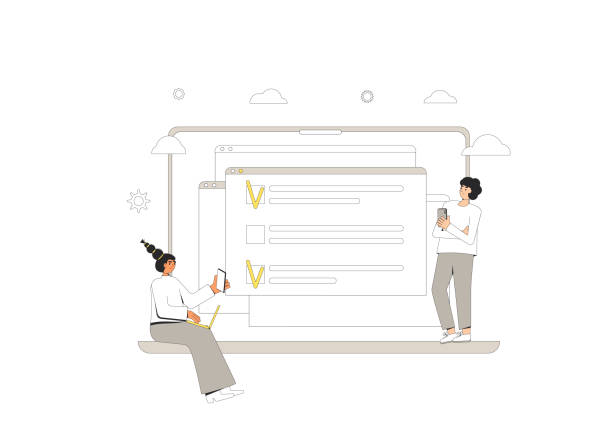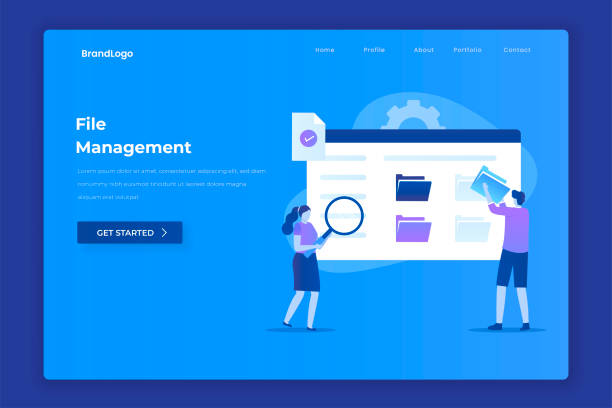Introduction to Secure Website Design and Its Importance

In the current digital age, secure website design is no longer an option, but an undeniable necessity.
With the increasing rise of cyber threats, every website, from a small personal blog to a large e-commerce platform, is at risk.
The importance of #website_security goes beyond mere data protection; it also includes maintaining #user_trust, preventing financial losses, and preserving #business_reputation.
An insecure website can lead to the theft of sensitive information, personal data breaches, and even the complete loss of a business.
Therefore, understanding the principles of #web_security_design and implementing them at every stage of website development is crucial.
This section provides an explanation of the concept of secure website design and why its importance is growing in today’s world.
We will examine common challenges in web security and how to address them, so that users and developers can approach this crucial issue with a more comprehensive perspective.
Any negligence in this area can have irreparable consequences, from unauthorized access to customer banking information to the complete destruction of the website’s structure.
Therefore, investing in knowledge and tools related to web security is a long-term investment for the stability and success of any online business.
This guide, aiming to raise awareness in the field of cybersecurity, elaborates on various aspects of secure website design.
Research shows that 80% of customers trust companies with a professional website more. Does your current website inspire this trust?
With Rasaweb’s corporate website design services, permanently solve the problem of customer distrust and a weak online image!
✅ Create a professional image and increase customer trust
✅ Attract more sales leads and grow your business
⚡ Get Free Consultation
Understanding Common Web Vulnerabilities and Cyber Threats

Understanding the enemy is the first step to fighting it.
To implement a secure website design, you must be familiar with the most common vulnerabilities and cyber attacks.
Among the most well-known of these vulnerabilities are SQL Injection, Cross-Site Scripting (XSS), and Cross-Site Request Forgery (CSRF).
These attacks can harm your website in various ways, from data theft to complete website control.
SQL Injection allows an attacker to gain access to the database by inserting malicious code into input fields.
XSS allows an attacker to inject malicious code into users’ browsers to steal their information or perform unwanted actions.
CSRF also tricks authenticated users into performing unwanted actions on the website.
Additionally, other threats such as DDoS (Distributed Denial of Service) attacks, malware attacks, and social engineering exist and must be considered.
DDoS attacks make a website unavailable by sending a massive volume of traffic to the server.
Malware can secretly be placed on your website to steal information or spread viruses.
Social engineering also obtains confidential information by deceiving users.
This analytical section helps you identify these weaknesses and threats to adopt effective strategies for increasing your web security.
Knowing how attackers think and what tools they possess is an important part of the website security process.
Best Practices for Secure Coding in Secure Website Design

Secure coding is the backbone of any secure website design.
Many vulnerabilities enter websites through programming errors.
To prevent these issues, adhering to best coding practices is essential.
Input Validation is the first and perhaps most important step.
Any data received from users must be carefully reviewed and sanitized to prevent the injection of malicious code or data.
Using Prepared Statements in the database to combat SQL injection, encrypting and hashing passwords instead of storing them as plain text, and using secure functions to generate random numbers are other vital measures.
Another important aspect is error handling and logging.
Generic error messages should be used instead of detailed error messages that could expose sensitive system information.
Accurate logging of system activities and unsuccessful login attempts is also crucial for identifying attack patterns.
Also, Session Management must be performed securely; strong session tokens and appropriate session expiration should be used.
Using up-to-date and secure frameworks and libraries with built-in security mechanisms can significantly lighten the burden on developers and facilitate the secure web development process.
Regular updates of these tools are also essential to counter discovered vulnerabilities.
This section provides practical guidance for programmers to write code that is resistant to attacks from the outset.
| Secure Coding Method | Description | Vulnerability Example |
|---|---|---|
| Input Validation | Review and sanitize user-entered data | SQL Injection, XSS |
| Using Prepared Statements | Separating SQL code from input data | SQL Injection |
| Hashing Passwords | Storing passwords as hashes (with Salt) | Database Leak |
| Secure Session Management | Using strong tokens and appropriate session expiration | Session Hijacking |
Database Security: The Backbone of Secure Website Design

The database is the heart of every website, and its maintenance in a secure website design is of utmost importance.
Sensitive user information, transactions, and website content are all stored in the database.
Therefore, any breach can be catastrophic.
The first step in securing a database is choosing a reputable database management system (DBMS) and keeping it updated.
Using strong and unique passwords for database user accounts, as well as restricting access based on the Principle of Least Privilege, is extremely vital.
This means that every user or application should only have access to the minimum data and operations necessary to perform its function.
Encrypting data, both in transit and at rest, creates an additional layer of protection.
For example, using SSL/TLS for communication between the website and the database, and encrypting columns containing sensitive information such as credit card numbers or national ID numbers, can prevent their disclosure in case of a breach.
Regular and tested database backups are also essential for data recovery in case of an attack or system failure.
Intrusion Detection Systems (IDS) and database monitoring tools can also help identify suspicious and unauthorized activities, providing timely alerts for quick response.
This specialized section provides comprehensive solutions for database security to ensure a secure web structure.
Did you know that customers’ first impression of your company is your website? Multiply your business’s credibility with a powerful corporate website from Rasaweb!
✅ Custom and eye-catching design tailored to your brand
✅ Improved user experience and increased customer attraction
⚡ Click to get free consultation with Rasaweb!
The Importance of Strong Authentication and Authorization in Secure Website Design

Authentication and Authorization are two fundamental pillars in secure website design.
Authentication is the process of verifying a user’s identity, while authorization determines what resources the authenticated user has access to and what actions they can perform.
Implementing strong authentication mechanisms, such as using complex passwords, Two-Factor Authentication (2FA), and even Multi-Factor Authentication (MFA), can largely prevent unauthorized access.
For passwords, strict policies should be enforced; including minimum length, a combination of uppercase and lowercase letters, numbers, and special characters.
Password storage must be hashed and salted so that passwords are not recoverable even if the database is breached.
In terms of authorization, the principle of least privilege must be followed.
Every user, whether a regular user or a system administrator, should only be granted the minimum access necessary to perform their duties.
Role-Based Access Control (RBAC) systems can be very useful in managing authorization complexities in large websites.
RBAC allows you to define different roles (such as user, editor, administrator) and grant access based on these roles.
This educational section shows you how to achieve a secure and attack-resistant website design and protect user data by precisely and intelligently implementing these two mechanisms.
The Role of SSL/TLS Certificates and HTTPS Protocol in Web Security

In today’s world, a website without HTTPS and an SSL/TLS certificate is not considered secure and cannot be part of a secure website design.
The HTTPS (Hypertext Transfer Protocol Secure) protocol is the secure version of HTTP that encrypts communication between the user’s browser and the website server.
This encryption prevents eavesdropping, data manipulation, and identity spoofing during information transfer.
SSL/TLS (Secure Sockets Layer/Transport Layer Security) certificates are the technology that enables this encryption.
Using HTTPS not only ensures user data security but also positively impacts your website’s SEO; Google prefers websites that use HTTPS in its search results.
SSL/TLS certificates come in various types, from DV (Domain Validation) certificates that only verify domain ownership, to OV (Organization Validation) and EV (Extended Validation) that verify more information about the organization’s identity and provide a higher level of trust to users.
Proper SSL/TLS implementation involves using the strongest encryption algorithms, avoiding old and vulnerable protocol versions (such as SSLv3), and appropriate server configuration.
Furthermore, ensuring that all website resources (images, scripts, CSS files) are loaded via HTTPS (Mixed Content) is essential for maintaining complete communication security.
This section explains the importance of security protocols in HTTPS and their vital role in creating comprehensive web security.
Web Application Firewalls (WAF) and Intrusion Detection/Prevention Systems (IDS/IPS)

Web Application Firewalls (WAF) and Intrusion Detection/Prevention Systems (IDS/IPS) are vital tools in the defense layers of a secure website design.
WAFs sit between users and the website server and analyze incoming traffic to identify and block malicious attacks.
They can provide protection against attacks such as SQL injection, XSS, and CSRF, which were mentioned earlier.
WAFs can be implemented as hardware, software, or cloud-based solutions.
The advantage of using a WAF is that even if code has a vulnerability, the WAF can stop an attack before it reaches the code.
Intrusion Detection Systems (IDS) and Intrusion Prevention Systems (IPS) continuously monitor the network and systems for suspicious activity patterns and anomalies that indicate an attempted intrusion.
IDS only provides alerts, while IPS can automatically block attacks.
These systems complement WAFs and provide a deeper layer of defense.
News related to cyber attacks constantly highlights the importance of these tools.
Large and small companies are investing in these technologies to increase their website security.
This analytical section examines how these tools work and their role in website security architecture, and provides news information on the latest advancements in this field.
| Security Tool | Main Function | Type of Protection |
|---|---|---|
| Web Application Firewall (WAF) | Filters and monitors HTTP traffic between a web application and the internet | Layer 7 Attacks (SQLi, XSS, CSRF) |
| Intrusion Detection System (IDS) | Monitors network traffic for suspicious activities and provides alerts | General threats, intrusion patterns |
| Intrusion Prevention System (IPS) | Like IDS, with automatic attack blocking capability | Active attacks, malicious traffic |
The Importance of Regular Security Audits and Penetration Testing

Even with the best secure website design and defensive mechanism implementation, websites are always exposed to new risks.
Technologies evolve, and along with them, attack methods also change.
For this reason, conducting regular security audits and Penetration Testing is crucial to identify and address vulnerabilities before they are discovered by attackers.
A security audit involves examining code, server configuration, network settings, and organizational security policies.
The goal is to identify and correct potential weaknesses.
Penetration testing, often performed by ethical hackers, simulates a real attack on the website.
These tests can uncover vulnerabilities that automated scanners or manual audits might overlook.
The report resulting from penetration testing provides valuable insight into the website’s actual weaknesses and practical solutions for addressing them.
This process should be repeated periodically and after any significant change in the website’s structure or code.
Additionally, Bug Bounty programs, where security researchers are rewarded for finding vulnerabilities, can be used as a supplementary tool to strengthen web security.
This guidance helps you develop a comprehensive plan for continuous evaluation and improvement of your website’s security.
Do you have an e-commerce website, but your sales aren’t as expected? Rasaweb solves your problem permanently with professional e-commerce website design!
✅ Significant increase in conversion rates and sales
✅ Unmatched user experience for your customers
⚡ Click to get free consultation with Rasaweb!
Incident Response and Disaster Recovery in Secure Website Design

Even with the best preventive measures in secure website design, the possibility of a security breach or disaster (such as server downtime or data loss) always exists.
Therefore, having a well-defined Incident Response Plan and Disaster Recovery Plan is of paramount importance.
An incident response plan should include identification, containment, eradication, recovery, and post-incident analysis phases.
This plan should specify who is responsible for what, how to communicate with stakeholders, and what tools are needed to counter an attack.
Speed and efficiency in incident response can make the difference between a minor issue and a major disaster.
The disaster recovery plan also focuses on restoring website functionality and data after an unexpected event.
This includes regular off-site backup strategies, recovery plans for systems and data, and periodic tests to ensure the effectiveness of the recovery plan.
The ultimate goal is to minimize downtime and maintain business continuity.
This specialized section explains the importance of preparing for worst-case scenarios and its role in incident response and securing web structure when facing unexpected challenges.
User Training and Security Awareness

Last but not least, the human element is a crucial aspect of secure website design.
Even the most advanced security technologies are vulnerable to human error.
Many successful attacks, such as phishing and social engineering, target users, not systems.
Therefore, user training and raising their security awareness are vital parts of a cybersecurity strategy.
For website users (general users and employees), training should be provided on identifying phishing emails, the importance of using strong and unique passwords, how to handle sensitive information, and avoiding clicking on suspicious links.
These trainings can be conducted as workshops, short videos, or even engaging content like games or competitions to make them more appealing.
Creating a security culture within the organization, where each individual takes responsibility for security, is very important.
This section, with its thought-provoking and engaging content, highlights the importance of cybersecurity training and thereby refers to social engineering and its role in ensuring a secure website design.
The main question is: Does your organization invest enough in training its most important asset, its employees and users? Are they aware of the existing risks and do they know how to protect themselves and their organization?
Frequently Asked Questions
| Row | Question | Answer |
|---|---|---|
| 1 | What is secure website design? | The process of designing and developing websites that are resistant to cyber attacks and protect user data and privacy. |
| 2 | Why is website security important? | To prevent data breaches, financial losses, damage to company reputation, and maintain user trust. |
| 3 | What are some common website security threats? | SQL Injection, XSS (Cross-Site Scripting), CSRF (Cross-Site Request Forgery), weak authentication, and outdated software. |
| 4 | What is SSL/TLS and what is its role? | Protocols for encrypting data between the user’s browser and the website server, ensuring secure and private communication. |
| 5 | How can SQL Injection attacks be prevented? | By using Prepared Statements/Parameterized Queries, input validation, and ORMs (Object-Relational Mappers). |
| 6 | What is the role of a Web Application Firewall (WAF) in security? | A WAF monitors and filters HTTP traffic between a web application and the Internet to prevent malicious attacks. |
| 7 | Why is regular updating of software and libraries essential? | Updates include patches for known security vulnerabilities that attackers can exploit. |
| 8 | How can XSS attacks be prevented? | By sanitizing and escaping all user inputs before displaying them on the web page and using a Content Security Policy (CSP). |
| 9 | What does the Principle of Least Privilege mean? | It means that users and systems are granted only the minimum necessary permissions to perform their tasks, preventing unnecessary access to resources. |
| 10 | What is the importance of proper user session management? | To prevent user session hijacking and unauthorized access to user accounts through secure and expiring session tokens. |
And other services of Rasaweb Advertising Agency in the field of advertising
Smart SEO: Revolutionize sales growth with the help of real data.
Smart Sales Automation: An innovative platform for improving click-through rates by optimizing key pages.
Smart Social Media: Transform customer behavior analysis with the help of user experience customization.
Smart Advertising Campaign: A fast and efficient solution for customer behavior analysis with a focus on marketing automation.
Smart Marketplace: A professional solution for campaign management focusing on precise audience targeting.
And over hundreds of other services in the field of internet advertising, advertising consultation, and organizational solutions
Internet Advertising | Advertising Strategy | Advertorials
Sources
Website Security from Zero to One HundredKey Tips for Secure Website DesignComprehensive Website Security GuideBest Practices for Web Security
? Are you ready to revolutionize your business in the digital world? Rasaweb Afarin Digital Marketing Agency, with expertise in areas such as responsive website design, professional SEO, and targeted advertising campaigns, offers innovative solutions for your sustainable growth. With us, have a powerful and memorable web presence.
📍 Tehran, Mirdamad Street, next to Central Bank, Southern Kazeroun Alley, Ramin Alley, No. 6




